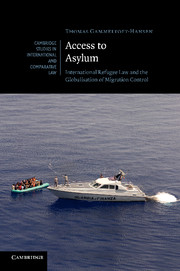Book contents
- Frontmatter
- Contents
- Foreword
- Preface
- Acknowledgements
- Table of treaties and other international instruments
- Table of cases
- 1 Introduction
- 2 The refugee and the globalisation of migration control
- 3 Refugee protection and the reach of the non-refoulement principle
- 4 Offshore migration control and the concept of extraterritorial jurisdiction
- 5 The privatisation of migration control and state responsibility
- 6 ‘Hic abundant leones’: the institutional reach of refugee protection
- 7 Conclusion
- Bibliography
- Index
- CAMBRIDGE STUDIES IN INTERNATIONAL AND COMPARATIVE LAW
3 - Refugee protection and the reach of the non-refoulement principle
Published online by Cambridge University Press: 03 May 2011
- Frontmatter
- Contents
- Foreword
- Preface
- Acknowledgements
- Table of treaties and other international instruments
- Table of cases
- 1 Introduction
- 2 The refugee and the globalisation of migration control
- 3 Refugee protection and the reach of the non-refoulement principle
- 4 Offshore migration control and the concept of extraterritorial jurisdiction
- 5 The privatisation of migration control and state responsibility
- 6 ‘Hic abundant leones’: the institutional reach of refugee protection
- 7 Conclusion
- Bibliography
- Index
- CAMBRIDGE STUDIES IN INTERNATIONAL AND COMPARATIVE LAW
Summary
The non-refoulement principle is often referred to as the ‘cornerstone’ or ‘centrepiece’ of the international refugee protection regime. Short of a right to be granted asylum, the guarantee that no refugee will be sent back to a place where he or she will be persecuted constitutes the strongest commitment that the international community of states has been willing to make to those who are no longer able to avail themselves of the protection of their own government. At the same time the non-refoulement obligation serves as the entry point for all subsequent rights that may be claimed under the 1951 Refugee Convention. Without this, little else matters.
In the initial encounter between the refugee and the authorities of a potential asylum state, the protection against refoulement naturally becomes the first and most important consideration. This chapter examines the geographical reach of the non-refoulement principle as a first and crucial step in determining states' international obligations in cases of offshore migration control.
The non-refoulement principle as enshrined in Article 33 of the Refugee Convention reads as follows:
1) ‘No Contracting State shall expel or return (‘refouler’) a refugee in any manner whatsoever to the frontiers of territories where his life or freedom would be threatened on account of his race, religion, nationality, membership of a particular social group or political opinion.
2) The benefit of the present provision may not, however, be claimed by a refugee whom there are reasonable grounds for regarding as a danger to the security of the country in which he is, or who, having been convicted by a final judgment of a particularly serious crime, constitutes a danger to the community of that country.’
- Type
- Chapter
- Information
- Access to AsylumInternational Refugee Law and the Globalisation of Migration Control, pp. 44 - 99Publisher: Cambridge University PressPrint publication year: 2011
- 1
- Cited by

